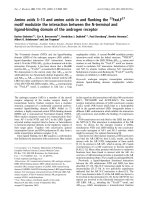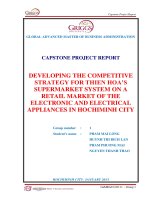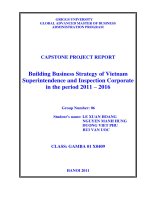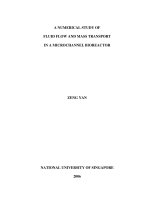Determination of urinary mandelic and phenylglyoxylic acids in ethylbenzene -exposed paint manufacturing workers in 2019
Bạn đang xem bản rút gọn của tài liệu. Xem và tải ngay bản đầy đủ của tài liệu tại đây (363.54 KB, 69 trang )
MINIST RY OF EDUCATION AND TRAINING MINISTRY OF HEALTH
DANG THI TRANG
DETERMINATION OF URINARY MANDELIC AND
PHENYLGLYOXYLIC ACIDS IN ETHYLBENZENE-EXPOSED
PAINT MANUFACTURING WORKERS IN 2019
Major : Preventive Medicine Doctor
Code : D720302
THESIS OF GRADUATION MEDICAL DOCTOR
COURSE 2015-2021
Supervisor
Assoc Prof Khuong Van Duy
PhD. MD Vti Xuan Trung
Hanoi “2021
r-u -ÍM Qỉ ugc V
Hl
ACKNOWLEDGMENT
I would like to offer my thanks to the Boards of Hanoi Medical
Universit}’. Institute of Preventive Medicine and Public Health, as well as the
teachers of the Department of Occupational Health for supporting me to do this
thesis in the most convenient conditions.
I would like to express mv great appreciation to all the individuals and
teams below, that without them. I would not be able to accomplish my
dissertation.
Firstly. I would like to express my deepest gratitude to my supervisor.
A/Prof. Khuong Van Duy for his patient guidance, enthusiastic encouragement
and useful critiques of this research work. His willingness to give his time so
generously has always been very much appreciated. Not only did I leant a lot
from his academic knowledge, but also his enthusiasm and professional attitude
towards work inspired me to pursue my career
I would like to offer mv special thanks to PhD. MD Vu Xuan Trung subject "Determination urinary Mandelic and Phenylglyoxylic acids in
ethylbenzene-exposed paint manufacturing workers and associated factors.
2019"- Code: 218/07/TLĐ for creating conditions for me to use data to write this
thesis
Last but not least 1 would like to give thanks to my family and close
friends, for their support and encouragement throughout my study
Hanoi May 2021
Dang Thi Trang
r-u -ÍM Qỉ ugc V
Hl
COMMITMENT
Respectfully addressed to:
- Board of Hanoi Medical University
- Board of Institute for Preventive Medicine and Public Health
- Department of Population
- Board of Dissertation Assessment
My name is Dang Thi Trang - Student of Hanoi Medical University,
course 2015 - 2021. majoring in Preventive Medicine Doctor, hereby declare
that:
This is a research that I participated under the scientific guidance of
Assoc.Prof Khuong Van Duy and PhD. MD Vu Xuan Trung. Tile research
content and research results in this tope are truthful. This study is part of the
project ’’.Nghiên cứu xác định mức (lộ thầm thấu cua Ethylbenzene thõng qua
sán phẩm chuyên hóa acid mandelic (MA) và acid phenylglyoxylic (PGA) trong
nước tiếu ở người lao dộng có tỉcp xúc"- Code: 218 07TI.Đ by PhD. MD Vu
Xuan Trung, who is Director of the Center for Occupational Health is the project
manager in 2019. Tire author lias allowed me to participate in the process of data
processing, analysis and use of this data for my graduation thesis.
In addition the thesis also uses a number of comments, assessments as
well as data from other authors, agencies and organizations, all with source
annotations clearly stated in the references.
If I find any fraud. I take full responsibility for the content of my thesis.
The author of the thesis
Dang Till Trang
TABLE OF CONTENTS
r-u -ÍM CỊỈ ugc V
Hl
INTRODUCTION...................................................................................
1
CHAPTER 1: LITERATURE REMEW ......................................................
3
1.1. Concepts and definitions............................................................................3
1.1.1. Employee.............................................................................................3
1.1.2. Occupational disease............................................................................3
1.1.3. Volatile organic compounds (VOC)....................................................3
1.2. Characteristics of ethylbenzene..................................................................3
1.2.1. Chemical and physical data, production and usage status....................3
1.2.2. Exposure, penetration, metabolism, and excretion...............................4
1.2.3. The effect of ethylbenzene...................................................................6
1.3. Research on exposure and biological monitoring of ethylbenzene exposed9
1.4. Associated factors impact on the level of the urinary Mandelic and
Phenylglyoxylic acids in ethylbenzene-exposed paint manufacture worker's.. 12
1.4.1. Associated factors among the concentration of urinary MA. PGA....12
1.4.2. High performance liquid cliromatographic (HPLC) for Determination
of Urinary Metabolites of Ethylbenzene.......................................................13
1.5. Paint industry in Vietnam.........................................................................13
1.6. Paint companies in Hung Yen and Hanoi.................................................14
CHAPTER 2: METHODS____________________________.....______________16
2.1. Study subjects..........................................................................................16
2.1.1. Study subjects....................................................................................16
2.1.2. Inclusion criteria................................................................................16
2.1.3. Exclusion criteria..............................................................................16
2.2. Location and time of study......................................................................16
2.2.1. Research location...............................................................................16
r-u -ÍM Qỉ ugc V
Hl
2.2.2. Research tune
2.3. Research Methods
16
16
2.3.1. Study design......................................................................................16
2.3.2. Sample size and samplingmethod......................................................17
2.2.3. Research variables andindicators.......................................................17
2.3.4. Instruments........................................................................................19
2.3.5. Data collection...... .................................................................
19
2.3.6. Sample analysis at the laboratory......................................................20
2.3.7. Evaluation criteria.............................................................................22
2.3.8. Data analysis........................,............................................................23
2.3.9. Bias and bias control.........................................................................23
2.3.10. Ethical consideration.......................................................................24
CHAPTER 3: RESULTS............ .......................................................... ........25
3.1. Characteristics of participants..................................................................25
3.2. Ethylbenzene and Styrene concentration in the working environment....27
3.3. The level of urinaiv MA and PGA in ethylbenzene-exposed paint
manufacturing workers.....................................................................................32
CHAPTER4: DISCUSSION..................... ...................................................
38
4.1. Characteristics of participants..................................................................38
4.2. Ethylbenzene and Styrene in the working environment...........................38
4.3. The level of ethylbenzene contamination through MA and PGA
metabolism products in urine...........................................................................41
4.4. Limitation of the study............................................................................45
CONCLUSION........................................................................................
46
RECON BIENDATIONS .......................................................................
47
REFERENCES
APPENDIX
Ss KJ;-.
r-u -ÍM CỊỈ ugc V
Hl
ABBREVIATIONS
The American Conference of Governmental Industrial
ACGIH
Hygienist
Benzene, toluene, ethylbenzene, xylene
BTEX
Benzene, toluene, xvlene
BTX
Central nervous system
CNS
Ethylbenzene
EB
Ethylbenzene and styrene
EBS
Environmental protection agency
EPA
High performance liquid chromatographic
HPLC
International Agency for Research on Cancer
I ARC
Mandelic Acid
MA
National Institute for Occupational Safety and Health
MOSH
Occupational Safety and Health Administration
OSHA
Phenylglyoxylic Acid
PGA
Volatile organic compounds
VOCs
Chromatography Mass Spectometry
GC'MS
Creatinin
Cre
International Agency for Research on Cancer
IARC
r-u -ÍM «£ ugc V
Hl
LIST OF TABLES
Table 2.1: Variables and research indicators.....................................................17
Table 2.2: Process and equipment used in the laboratory..................................20
Table 2.3: Acceptable concentrations of ethylbenzene and styrene in the
working environment..................................................................22
Table 3.1: Demographic characteristics of participants....................................25
Table 3.2: Characteristic of participants in the working process.......................26
Table 3.3: Lifestyle habits of participants.........................................................26
Table 3.4: Distribution of ethylbenzene and styrene samples exceeded the
permissible limit in the working environment..................................................27
Table 3.5: The average concentration of Ethylbenzene and Styrene in the
working environment...................................................................28
Table 3.6: Individual Ethylbenzene and Styrene samples that exceeded the
permissible limit..........................................................................29
Table 3.7: Individual ethylbenzene and styrene concentration (8 hour's).........30
Table 3. 8: Urinary MA and PGA acids concentration...................................32
Table 3. 9: Total urinary concentration of MA andPGA.................................32
Table 3.10: Total concentration of MA- PGA by age....................................33
Table 3.11: Totalconcentration of MA-!- PGA by working period.................34
Table 3.12: Totalconcentration of MA— PGA by working position............35
Table 3.13: Totalconcentration of MA- PGA by paint companies..................36
LIST OF FIGURES
Figure 1.1: Ethylbenzene metabolism in the human body..................................5
Figure 2.1: The process of sampling and analysing ethylbenzene and styrene in
the workers’ ambient air....................................................................................19
Figure 3.1: Total concentration of MA and PGA in participants.......................33
Figure 3.2: Correlation between ethylbenzene concentration and the total
concentration of MA and PGA in the urine..................................37
ABTRACTS
Background: Currently. many countries have used the ethylbenzene
metabolic products in urine is MA. and PGA as biological monitoring index for
ethylbenzene-exposed workers. There is no biological monitoring for
ethylbenzene in Vietnam The research aimed to: Determine ethylbenzene and
styrene concentrations in tile working environment through environmental
monitoring and individual dose monitoring, and Determine the level of urinary
MA and PGA in ethylbenzene-exposed paint manufacturing workers in 2019
Methods: A cross sectional study was conducted in Painting Company
from January' 2019 to April 2021. SPSS and Minitab software described
frequency tables; Pearson's correlation evaluated the correlation of ethylbenzene
concentration in the working environment with ethylbenzene's metabolite in
urine.
Results: The average ethylbenzene and styrene concentrations in the
working environment was 49.58 ± 34.67mg/m5. and 1.13 ± 0.97 mg/nf.
respectively (within the permissible limit). The individual ethylbenzene
concentration (8 hours) in the Mixing group was 99.77 ± 62.72 mg-’nf and in the
Quality' Control and Packing group was 19.58 ± 17.07 nig/m 5. The average
concentration of urinary MA and PGA were 77.21 ± 75.lSmg/g creatinine and
46.58 ± 51.76mg/g creatinine, respectively. The total average concentration of
MA + PGA was 123.08- 101.83mg'g creatinine. Correlation coefficient between
ethylbenzene concentration and the total concentration of MA and PGA in the
urine was 0.82
Conclusion: The maximum concentration of ethylbenzene and sty rene at
3 research facilities was within the permissible limit. The average total
concentration of MA and PGA in tile three companies were within the
permissible limit according to ACGIH. There is a strong correlation between
ethylbenzene exposure and tile metabolite in tile urinaiy(MA and PGA) (r =
0.82).
Key words: MA. PGA. Ethylbezene. Ethylbenzene-exposed. Styrene
-ÍM Qỉ ugc V
Hl
1
INTRODUCTION
Every day approximately 6.400 people die from occupational accidents or
diseases'-. Almost 2 million deatlis are due to fatal work-related diseases every
year. Furthermore, work-related diseases represent the main cause of death at
work, killing almost six times more workers than occupational accidents. It is
estimated that 2.7% of the disease burden worldwide can be attributed to
quantified occupational risks2. In 2019. the proportion of the population aged 15
and over participating in the work was estimated to be 61% After the home
environment, the workplace is where employees spend most of the time. During
that time, workers may be exposed to many health risk factors 2.
The harmful chemical substances are ubiquitous in manufacturing,
construction, and service-sector workplaces4. Die volume of chemicals in
commerce increased a great deal during the 20* centuiy especially synthetic
organic chemicals5. Due to their toxicity and carcinogenic potential, volatile
organic compounds (VOCs) cause hazardous effects on human health. Among
the monoaromatic volatile organic compounds, benzene and its derivatives are
highlighted.
Ethylbenzene (EB) is representative species of benzene homologue,
which is recognized as an occupational pathogen in Vietnam and many
countries6. According to The National Institute for Occupational Safety and
Health (NIOSH) of the American and the Occupational Safety and Health
Administration (OSHA). Ethylbenzene is potential for widespread human
exposure because of structural similarity to benzene and toluene . It lias been
classified as possibly carcinogenic to humans (Group 2B) by the International
Agency for Research on Cancer (IARC) S. Occupational workers exposed to a
mixture of solvents including Ethylbenzene were reported to express the effect
on hearing, kidney. DNA^?0.".
-ÍM Qỉ ugc V
Hl
2
The number of workers working with organic solvents is increasing in
Vietnam '. Benzene (B). Toluene (T). Ethylbenzene and Xylene (X) are used
commonly in the paint industry, so workers are at a high risk of exposure to
organic solvent13. Ethylbenzene is also a major component of mixed xylenes used
as solvents in paints*4. In fact, it is difficult to detect occupational diseases
caused by Ethylbenzene because Ethylbenzene is a minor component and usually
detected in combination with major components such as benzene, toluene and
xylene isomers* ■. The paint manufacturing industry is glowing much stronger,
with each production facility having more than 50% of the production workers
directly exposed to organic solvents, including Ethylbenzene16.
There are regulations on biological monitoring for benzene, toluene,
xylene in Vietnam but there is no biological monitoring for Ethylbenzene The
protection of workers exposed to Ethylbenzene is not enough concerned. Human
In vivo studies has shown that MA and PGA are also the major uiinaiy
metabolites of Ethylbenzene exposure18?9. Currently, many countries have used
the Ethylbenzene metabolic products in urine is Mandelic acid (MA) and
Phenylglyoxylic acid (PGA) as biological monitoring index for ethylbenzeneexposed workers (according to ACGHI) 6. Besides it. there is still a lack of
research on Ethylbenzene contamination in workers. Therefore, the research is
"Determination of urinary Mandelic and Phenylglyoxylic acids in ethylbenzeneexposed paint manufacturing workers in 2019" with two objectives:
1. To determine Ethylbenzene and Styrene concentrations in the working
environment through environmental monitoring and individual dose monitoring
in 2019.
2. To determine the level of urinary Mandelic and Phenylglyoxylic acids in
ethylbenzene-exposed paint manufacturing workeis in 2019.
-ÍM CỊỈ ugc V
Hl
3
CHAPTER 1
LITERATI RE REMEW
1.1. Concepts and derm it ions
1.1.1. Employee
Employee means a person who is full 15 years or older, lias the ability to
work, works under a labour contract is paid with wage and is managed and
controlledbv ail employer'0
1.1.2. Occupational disease
According to WHO. an “occupational disease” is any disease contracted
primarily as a result of exposure to risk factors arising from work activity-ByMay 2016. there are 34 occupational diseases entitled to insurance in Vietnam
divided into 5 main groups:
- Group 1: Pulmonary and bronchial diseases.
- Group 2: Occupational poisoning diseases.
- Group 3: Occupational diseases caused by physical agents.
- Group 4: Occupational skin diseases.
- Group 5: Occupational diseases caused by biological agents.
1.1.3. Volatile organic compounds (VOC)
voc means any compound of carbon, excluding carbon monoxide, carbon
dioxide, carbonic acid, metallic carbides or carbonates and ammonium
carbonate. which participates in atmospheric photochemical reactions, except
those designated by EPA as having negligible photochemical reactivity 22.
1.2. Characteristics of Ethylbenzene
1.2.1. Chemical and physical data, production and usage status
Ethylbenzene is an organic compound with the formula CgH10. It is a
highly flammable, colorless liquid with an odor similar to gasoline2'.
The formula is CẠHẠCH<:H;, the structural formula of ethylbenzene is:
r-u -ÍM CỊỈ ugc V
Hl
4
Ethylbenzene Iras numerous uses,
benzene and ethylene, will ch is commonly mixed with other organic solvents. It
lias a very important role in the peưochemical industry. as an intermediate in the
production of styrene. a precursor to polystyrene, a common plastic.
Ethylbenzene is found naturally in coal tar and petroleum and is used in styrene
manufacturing (99%). Ethylbenzene is also present in commercial mixed xylenes
at levels up to 25%. As such, it is present in many paints and lacquers, printing
inks, insecticides and solvents in the rubber and chemical manufacturing
industries25. The research in 2016 showed that the paint and varnish workplaces
liad significant BTEX sources25. Ethylbenzene exposure can be determined by
testing for the metabolites in urine26
1.2.2. Exposure, penetration, metabolism, and excretion
Most occupational exposures to ethylbenzene result from rhe use of
products containing technical grades of mixed xylenes. Workers can be exposed
to ethylbenzene by various; common sources, including gasoline carpet, glues,
varnishes,
paints,
solvents,
tobacco
products,
automobile
products 50.
Ethylbenzene penetrates into the body mainly in 3 ways:
- Inhalation: most exposures occur by inhalation with up to 99% of tire
exposure2'. Ethylbenzene is easily absorbed through the respiratory tract.
-■c -ÍM «£ Hgc V
Hl
5
- Skin and eye contact: ethylbenzene enters the human body through the
skin and the naked eye in liquid form.
- Gastrointestinal: during occupational exposure is uncommon for this route
(only 1 - 2% caused by food consumption).
Ethylbenzene enters the human body mainly through iiứialation inhalatio-n.
When entering the human body, ethylbenzene is metabolized according
Figure 1.1: Ethylbenzene metabolism in the human body ■■
Once in die body, ethylbenzene is broken down into other chemicals. Most of
these other chemicals leave the body in the urine within 2 days. Small amounts
can also leave through the lungs and in faeces. Among the 4500 participants in a
study in the United States, the detection rate of Mandelic and Phenylglyoxylic
acids was 98.9% and 90.6%. respectively2’. In another study, mandelic and
phenylglyoxylic acids amounted to 90% of the ethylbenzene metabolites’*.
1.2.3. Ute effect of ethylbenzene
- Short-term exposure
Exposure to high ethylbenzene levels for shot! periods can cause
-■c -ÍM CỊỈ ugc V
Hl
6
respiratory effects such as eye irritation, throat irritation and chest constriction.
Exposure to higher levels can result in vertigo and dizziness even deceased
10
.
Animal studies have reported central nervous system (CNS) toxicity, pulmonary
effects, and effects on the livei\ kidney, and eyes (irritation) front acute inhalation
exposure to ethylbenzene50.
- Long- term exposure
An animal study indicated that exposure to ethylbenzene resulted in
increased incidences of renal tubule hyperplasia and increased severities of
nephropathy. Exposure of male mice to ethylbenzene resulted in increased
incidences of alveolar epithelial metaplasia, syncytial alteration of hepatocytes,
hepatocellular hypertrophy, hepatocyte necrosis, and thyroid gland follicular cell
hyperplasia. In female mice, ethylbenzene exposure resulted in increased
incidences of eosinophilic foci of the liver: pituitary- gland pars distalis
hyperplasia, and thyroid gland follicular cell hyperplasia.
- Risk of cancer
Thousands of chemical compounds ate used in paint products, like
pigments, extenders, binders, additives, and solvents (toluene, xylene,
ethylbenzene, ketones, alcohols, esters, and glycol ethers). Paint manufacture
workers ate potentially exposed to the chemicals present in paint products,
although tire patterns and levels of exposure to individual agents may differ from
those of painters. Ethylbenzene is ubiquitously combined with BTX. commonly
used in the paint industry, so workers who are at ltigh risk of exposure to organic
solvent [13]. According to recent studies, occupational exposure to paint may
cause an increased risk of several kinds of cancer.
r-u -ÍM Qỉ Hgc V
Hl
7
including lung, bladder and pancreas cancer1, and lymphatic and hematopoietic
tumors5*. Chronic occupational exposure to paints may lead to a slightly
increased risk of genetic damage among paint industry worker' 3. These findings
are consistent with the 1989 report issued by the International Agency for
Research on Cancer, which classified painting as an occupationally related cause
of cancer and provided furtlier evidence that certain cancers' risk increased by
exposures in lire paint manufacturing process. However, occupational exposure
in paint manufacture is not classifiable as to its carcinogenicity 34
Ethylbenzene has been classified as possibly carcinogenic to humans
(Group 2B) by the International Agency for Research on Cancer (IARC) 8. Under
the conditions of these 2-year inhalation studies, there was clear evidence of
carcinogenic activity of ethylbenzene in male F344/N rats based on increased
incidences of renal tubule neoplasms. The incidences of testicular adenoma were
also increased. There was some evidence of carcinogenic activity of
ethylbenzene in female F344/N rats based on increased incidences of renal
tubule adenomas. There was some evidence of carcinogenic activity of
ethylbenzene in male B6C3F1 mice based on increased incidences of
alveolar/bronchiolar neoplasms. There was some evidence of carcinogenic
activity of ethylbenzene in female B6C3F1 mice based on increased incidences
of hepatocellular neoplasms7.
- Impact oil DX4
Hugo et al. (2011) showed that chronic occupational exposure to paints
might lead Io a slightly increased risk of genetic damage among paint industry
worker35. The Comet assay in epiúielia buccal cells showed that the damage
index and damage frequency observed in tire exposed group were significantly
higher than the control group (P < 0.05). In the same way. the Comet assay data
in peripheral blood leukocytes showed that both analysis parameters (DI and
ĐI’) were significantly greater than that for the control group (P < 0.05).
r-u -ÍM «£ Hgc V
Hl
8
Fu-Kuei Chang et al. (2010) assessed the relationships between
ethylbenzene exposure and levels of 8- hydroxydeoxyguanosine (8-OHdG)
among spray painters. Sixty-four male workers employed at a large shipyard
were recruited for this investigation. Fifteen spray painters exposed to paint and
two noil-exposed groups, namely 19 sandblasting workers and 30 office staffs,
were selected as the subjects. Personal exposure to xylene and ethylbenzene in
the air were collected using diffusive samplers. Urine samples of the spray
painters were collected after a month-long holiday leave and during the pre- and
post-work shifts. Urine samples of sandblasting workers and office staffs were
gathered after their shift. Urinary mandelic acid and methyl hippuric acid were
used as biological indices of ethylbenzene and xylene doses, respectively.
Urinary 8-OHdG was used as a biomarker of oxidative DNA damage. The postwork shift concentration of urinary' 8-OHdG for 10 spray painters significantly
exceeded that of holiday leave. The post-work shift concentration of urinary 8OHdG was higher among 15 sprays than sandblasting workers and office staffs.
This pilot study suggests that occupational exposure to paint increases oxidative
DNA injury. Moreover, urinary' 8-OHdG levels displayed greater DNA damage
in spray painters than other unexposed groups and their holiday leave samples. A
significant correlation was found between urinary' 8-OHdG and exposure to
ethylbenzene. The ethylbenzene exposure could not explain all urinary 8- OHdG
measured5.
r-u -ÍM «£ Hgc V
Hl
9
compounds) by inhalation. 6 h/day. 6 days/week for 13 weeks and sacrificed for
morphological investigation s weeks after the end of exposure. Ethylbenzene
produced moderate to severe ototoxicity in rats exposed to the four
concentrations studied. Increased thresholds were observed at 2. 4. s and 16 kHz
in rats exposed to 400. 600 and SOO ppm ethylbenzene. Moderate to severe
losses of outer hair cells of the organ of Corti occurred in animals exposed to the
four concentrations studied. Exposure to both mixed xylenes produced
ototoxicity characterized by increased auditor} - thresholds and losses of outer
hair cells. Ototoxicity potentiation caused by ethylbenzene was observed.
Depending on the mixed xylene studied and the area of the concentrationresponse curves taken into account the concentrations of ethylbenzene in mixed
xylenes necessary to cause given ototoxicity were 1.7- 2.8 times less titan those
of pure ethylbenzene. Given ethylbenzene's high ototoxicity, the safety margin of
less or equal to two (LOAELTWA) might be too small to protect workers from
the potential risk of ototoxicity. Moreover, the enhanced ototoxicity of
ethylbenzene and para-xylene observed in mixed xylenes should encourage the
production of mixed xylenes with tile lowest possible concentrations of
ethylbenzene and para-xvlene11.
13. Research on exposure and biological monitoring of ethylbenzene exposed
In Vietnam, research on ethylbenzene and its metabolites are limited.
Therefore, we focus on renewing the research of countlies around tile world.
Ethylbenzene and its metabolites were detected in human blood in 1985 s6. urine
in 1961s'. Most of the monitoring data have come from occupational studies of
specific worker populations exposed by inhalation. In people exposed to
inhalation, the main metabolites of ethylbenzene are mandelic acid (about 6471%) and phenyl glyoxylic acid (about 19-25%) ss s*
40
. Based on data from
human and animal studies, products for biological monitoring of ethylbenzene
have been identified by many studies as mandelic acid and phenylglyoxylic acid
r-u -ÍM CỊỈ Hgc V
Hl
1
0
-'6.
In a study in 1970. in eight-hour inhalation experiments with volunteers in
a gas chamber, the biotransformation of ethyl benzene, styrene, and umethylstyrene was investigated. About two-thirds of tlie vapors are retained in
the respiratory tract. After the inhalation was terminated only traces were found
in the expired air in tlie case of ethyl benzene, but no exhaled styrene could be
detected. The main urine metabolite of ethyl benzene and styrene in man is
mandelic acid; a smaller portion is eliminated as phenylglyoxylic acid and. in the
case of ethyl benzene, as methvlphe-nylcaibinol. Mandelic acid is excreted
rapidly from the organism; its determination in urine may be recommended as an
index of exposure for ethyl benzene as well as for styrene 41.
Engstrom et al. (1984); four volunteer subjects were exposed to IJOpprn
(655 mg/m5) of ethylbenzene and 150ppm (655mg/m3) of m-xylene both
separately and in combination. The biotiansformation of the solvents was studied
on the basis of the metabolites found in the urine. The metabolic conversion of
both m-xylene and ethylbenzene proceeded mainly through the oxidation of side
chains. Mandelic and phenylglyoxylic acids amounted to 90% of the
ethylbenzene metabolites, whereas m-xylene was excreted to 97% in tile form of
m-methylhippuric acid. Almost equimolar amounts in the form of metabolites of
both solvents were found in the urine during 24h from the onset of exposure.
Most of the ethylbenzene metabolites were excreted at substantially slower rates
than those of m-xylene. The combined exposure resulted in a mutual inhibition
of the metabolism of ethylbenzene and m- xylene. which was demonstrated by
delayed excretion and decreased amounts of metabolites excrete 1*.
r-u -ÍM QỈ Hgc V
Hl
1
1
Jang et al. (2000) studied a total of 20 male workers who liad been
exposed to a mixture of ethylbenzene and xylene through painting and solvent
mixing with commercial xylene in the metal industry. Environmental and
biological monitoring was performed during an entire week. The urinary
metabolites monitored were mandelic acid for ethylbenzene and mefiiylhippuric
acid for xylene. The average environmental concentration of organic solvents
was 3.42 ppm for ethylbenzene and 12.77 ppm for xylene. The urinary level of
mandelic acid corresponding to 100 ppm of ethylbenzene was found to be 0.7g/g
creatinine55.
Janasik et al. (200S) studied ethylbenzene exposure in six male volunteers
subjected to an exposure chamber containing ethylbenzene and toluene, xylene,
and mesitylene at concentrations emulating Polish occupational exposure
standards of 100 mg/m5. Blood and urine samples Obtained from the volunteers
were analyzed. Ethylbenzene concenirations in the blood ranged from 20 to
200pg/L. while urine concentrations ranged from I to 152pg/L-ổ.
Inoue et al. (2013) studied 360 solvent workers and 2S1 controls in Cliina.
Monitoring personal exposures showed that ethylbenzene exposure was low
(geometric mean 1.8 ppm). Urine samples collected at the end of the eight- hour
shift were analyzed for phenylglyoxylic and mandelic acids by high- pressure
liquid chromatography at 257nm. Despite the low level of the exposures, a
significant correlation was observed between ethylbenzene exposure and urinary
phenylglyoxylic acid, with high (0.6-0.7) correlation coefficients, suggesting that
urinary phenylglyoxylic acid is a good marker of occupational exposure to
ethylbenzene. Mandelic acid also correlated with ethylbenzene exposure, but
with much smaller coefficients (0.2). possibly because the method employed was
more sensitive to phenylglyoxylic acid than to mandelic acid42.
ACGIH proposes tliat the biological monitoring index for workers
exposed to ethylbenzene is the tot ad concentration of mandelic acid and
r-u -ÍM «£ Hgc V
Hl
1
2
phenylglyoxylic acid in die urine, the allowable limit of 0. 15g/g creatinine 26.
The index and its value proposed from 2007 until now are still used.
1.4. Associated factors impact on the level of the urinary Mandelic and
Phenylglyoxylic acids in ethylbenzene-exposed paint manufacturing workers
1.4.1. Associatedfactors among the concentration of urinary- MA, PGA
Capella et al. ethylbenzene and styrene (EB/S) exposure were quantified
from their common metabolites measured in spot urine samples obtained from
4690 participants (> 6 years old) in the 2005-2006 and 2011-2012 29. EB/S
metabolites MA and PGA were measured using ultra-high-performance liquid
clưomatography coupled with electrospray ionization tandem mass spectrometry
(UPLC-ESI-MS MS). MA and PGA were detected in 98.9% and 90.6% o-f
tested urine specimens, respectively. Exclusive smokers liad 2-fold and 1.6-fold
higher median urinary MA and PGA. respectively, compared with non-users.
Sample weighted regression analysis among exclusive smokers showed that
smoking 0.5 pack cigarettes per day significantly increased MA (+97.9pg/L) and
P(i/\ (+69.3pg/L). controlling for potential confoundcrs.
In comparison, exposure from the median daily dietary intake of grain
products increased MA by 1.95 pg/L and was not associated with statistically
significant changes in urinary PGA levels. Conversely, consuming vegetables
and fruit was associated with decreased MA and PGA. These results confirm
tobacco smoke as a major source of ethylbenzene and styrene exposure for the
general U.S. population29.
-ÍM CỊỈ Hgc V
Hl
1
3
Research by Angerer et al. showed that co-exposure to other Chemicals
could lead to decreased metabolism and decreased excretion of small
metabolites4-’.
1.4.2. High performance liquid chromatographic (HPLC) for determination of
Urinary Metabolites of Ethylbenzene
A
simple,
sensitive,
and
reproducible
high-performance
liquid
chromatographic procedure is described for the simultaneous determination of
urinary7 metabolites: MA and PGA from EB; hippuric acid from toluene, and
hippuric methyl acids from xylenes. The employed mobile phase and the
chromatographic conditions allowed relatively low detection limits (0.1 to
02mg/L). The method tested on 33 workers in the paint industry' and on 33
nonoccupationally exposed Tunisian subjects. A significant difference in
metabolite concentrations was found between the two groups. Most of the
measured levels were lower in the exposed group than the biological exposure
indices [40]. This method is also recommended for the determination of MA, a
metabolite of EB in the urine, by the Vietnam National Institute of Occupational
Safety and Health (VNNIOSH)4’.
1.5. Paint industry in Vietnam
In Vietnam, the number of workers working with organic solvents is
increasing. According to statistics, only the leather and footwear industry'
currently has about 450 enterprises with more than 500.000 employees; the
number of workers exposed to organic solvents accounts for over one-third of the
total number of workers12.
With the high-speed development in 2008 (average growth rate of 15 20% per year), the number of paint manufacturing enterprises is increasing 16. In
2019-. Vietnam had more than 600 paint manufacturing and trading enterprises.
In particular, since most of the world's major paint companies have appeared in
Vietnam, the market competition lias become more and more exciting. According
r-u -ÍM CỊỈ ugc V
Hl
1
4
to the Vietnam Paint and Ink Association, in the last 5 years, al though foreign
paint has few businesses involved, they accounted for 65% of the Vietnam
market, while domestic paint only accounted for 35% ' 5. Currently. there are no
specific statistics. However, the number of employees working in paint
production establishments ranges from a few tens to several thousand depending
on tlie facility's size. However, out of títe total number of employees, more than
50% of the establishment’s workers are exposed to organic solvents.
The manufacturing procedure paint
- Raw material: resin, pigment and additive agents are generally major
components of paint.
- Mixing: resin, pigment and solvent are mixed to produce an even mill base
- Milling: mill base produced at the pre-mixing process is sent to the
disperser to disperse the pigment particles finely.
- Blending: resin, additive agents, and so on are added to the mill base, the
dispersion of which is complete, also the colour phase is adjusted with colour
materials.
- Filtering: blended and toned paint is filtrated.
- Packing: filtrated paint is packed into a container.
- In general, paint production is through four main stages: input materials,
plastic synthesis workshop. paint workshop (crashing, mixing), and Packing
products.
1.6. Paint companies in Hung Yen and Hanoi
Hanoi General Paint Company was established in September 1970 as a
leading paint manufacturing company in Vietnam Throughout its history;
r-u -ÍM CỊỈ Hgc V
Hl
1
5
Hanoi Paint Company' has continuously grown and developed, providing tens of
thousands of tons of paints and printing inks for many industries in the
international economy Currently, Hanoi Paữit Company has 265 branches
nationwide, especially in the northern region. Hung Yen Paint company is are
large-scale company with a larger workshop area than in Hanoi paint company.
Besides, it has one branch at Hung Yen. where we also perform research.
r-u -ÍM QỈ ugc V
Hl
CHAPTER 2
METHODS
2.1.
Study subjects
2.1.1. Study subjects
- Paint manufacturing workere who are directly involved in production
exposed to ethylbenzene.
- The work]ng environment
2.1.2. Inclusion criteria
- 1 s years old and above.
- Years of work of at least 12 months.
- Agreeing to participate in the test and interview.
2.1.3. Exclusion criteria
- Under 18 years old.
- Years of work under 12 months.
- Do not agree to participate in the study.
2.2. Location and time of study
2.2.1. Research location
- Painting Company 1 and 2 in Hung Yen.
- Hanoi Paint Company (Company 3).
2.2.2. Research time
From Januaiy 2019 to April 2021. in which collecting data from January
2019 to December 2019.
23. Research Methods
2.3.1. Study design
The cross-sectional study.









